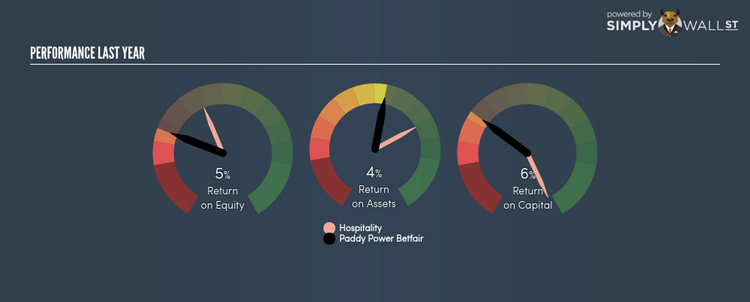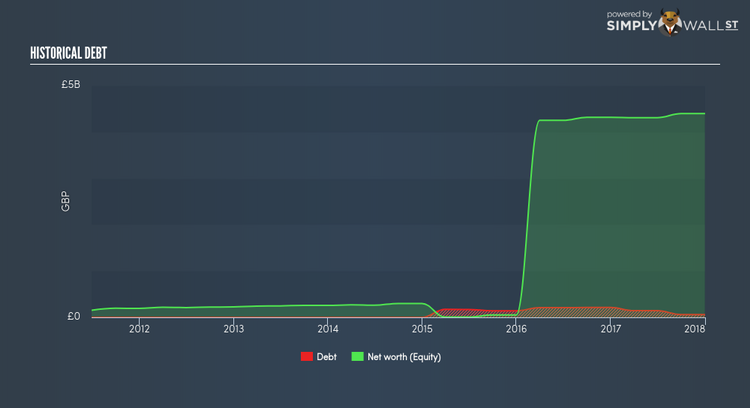What You Must Know About Paddy Power Betfair plc’s (ISE:PPB) 4.95% ROE

Paddy Power Betfair plc’s (ISE:PPB) most recent return on equity was a substandard 4.95% relative to its industry performance of 11.25% over the past year. An investor may attribute an inferior ROE to a relatively inefficient performance, and whilst this can often be the case, knowing the nuts and bolts of the ROE calculation may change that perspective and give you a deeper insight into PPB’s past performance. Metrics such as financial leverage can impact the level of ROE which in turn can affect the sustainability of PPB’s returns. Let me show you what I mean by this. See our latest analysis for Paddy Power Betfair
Breaking down ROE — the mother of all ratios
Return on Equity (ROE) weighs Paddy Power Betfair’s profit against the level of its shareholders’ equity. An ROE of 4.95% implies €0.05 returned on every €1 invested. Generally speaking, a higher ROE is preferred; however, there are other factors we must also consider before making any conclusions.
Return on Equity = Net Profit ÷ Shareholders Equity
ROE is assessed against cost of equity, which is measured using the Capital Asset Pricing Model (CAPM) – but let’s not dive into the details of that today. For now, let’s just look at the cost of equity number for Paddy Power Betfair, which is 8.98%. Since Paddy Power Betfair’s return does not cover its cost, with a difference of -4.03%, this means its current use of equity is not efficient and not sustainable. Very simply, Paddy Power Betfair pays more for its capital than what it generates in return. ROE can be dissected into three distinct ratios: net profit margin, asset turnover, and financial leverage. This is called the Dupont Formula:
Dupont Formula
ROE = profit margin × asset turnover × financial leverage
ROE = (annual net profit ÷ sales) × (sales ÷ assets) × (assets ÷ shareholders’ equity)
ROE = annual net profit ÷ shareholders’ equity
The first component is profit margin, which measures how much of sales is retained after the company pays for all its expenses. Asset turnover shows how much revenue Paddy Power Betfair can generate with its current asset base. And finally, financial leverage is simply how much of assets are funded by equity, which exhibits how sustainable the company’s capital structure is. Since financial leverage can artificially inflate ROE, we need to look at how much debt Paddy Power Betfair currently has. At 1.42%, Paddy Power Betfair’s debt-to-equity ratio appears low and indicates that Paddy Power Betfair still has room to increase leverage and grow its profits.
Next Steps:
While ROE is a relatively simple calculation, it can be broken down into different ratios, each telling a different story about the strengths and weaknesses of a company. Paddy Power Betfair’s ROE is underwhelming relative to the industry average, and its returns were also not strong enough to cover its own cost of equity. However, ROE is not likely to be inflated by excessive debt funding, giving shareholders more conviction in the sustainability of returns, which has headroom to increase further. ROE is a helpful signal, but it is definitely not sufficient on its own to make an investment decision.
For Paddy Power Betfair, I’ve put together three relevant factors you should further research:
Financial Health: Does it have a healthy balance sheet? Take a look at our free balance sheet analysis with six simple checks on key factors like leverage and risk.
Valuation: What is Paddy Power Betfair worth today? Is the stock undervalued, even when its growth outlook is factored into its intrinsic value? The intrinsic value infographic in our free research report helps visualize whether Paddy Power Betfair is currently mispriced by the market.
Other High-Growth Alternatives : Are there other high-growth stocks you could be holding instead of Paddy Power Betfair? Explore our interactive list of stocks with large growth potential to get an idea of what else is out there you may be missing!
To help readers see pass the short term volatility of the financial market, we aim to bring you a long-term focused research analysis purely driven by fundamental data. Note that our analysis does not factor in the latest price sensitive company announcements.
The author is an independent contributor and at the time of publication had no position in the stocks mentioned.

 Yahoo Finance
Yahoo Finance 

